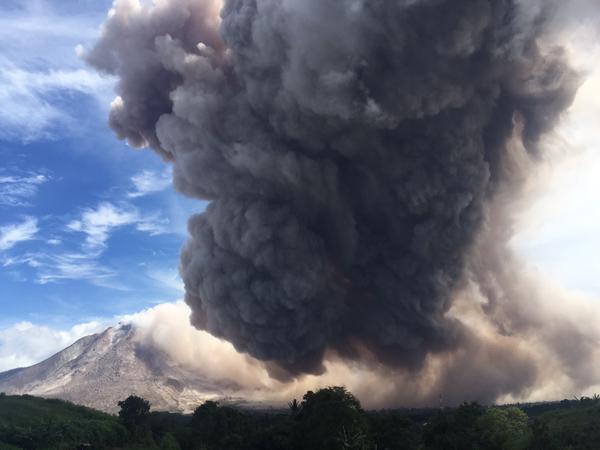
Environment videographer James Reynolds has been on the Indonesian island of Sumatra since Thursday, sharing video of Sinabung's intense eruptions of ash and gas. In Reynolds' video above, Sinabung's pyroclastic flow surges down the mountainside on Friday, destroying everything in its path, including farms. The beginning of the video shows how pyroclastic flow can pour down the side of a volcano like an avalanche.
The USGS says that pyroclastic flow — made up of small pieces of rock, ash and hot gas — can vary in speed, it is universally deadly and destructive. "A pyroclastic flow will destroy nearly everything in its path," says the USGS. "With rock fragments ranging in size from ash to boulders traveling across the ground at speeds typically greater than [50 mph], pyroclastic flows knock down, shatter, bury or carry away nearly all objects and structures in their way.
"The extreme temperatures of rocks and gas inside pyroclastic flows, generally between [400 and 1,300 degrees Fahrenheit], can cause combustible material to burn, especially petroleum products, wood, vegetation, and houses."
Mount Sinabung probably rested dormant without eruption for 400 years, says the USGS, until it exploded into life on Aug. 29, 2010, and has remained active ever since. "Sinabung is a small, composite, andesitic volcano," the USGS says, which means the cone-like mountain was formed from layers of lava and ash over thousands of years. The service says that Sinabung's summit is just over 8,000 feet, but "rises only a thousand meters or so above the surrounding terrain, much of which is dotted with numerous small farms."
On Wednesday, the Associated Press reported that authorities in Indonesia were having a difficult time convincing residents closest to the volcano to stay away for their own safety:
"We have lost our vegetables, but not coffee," said Sapta Sembiring Palawi from Gambir village, about 4.7 kilometers (3 miles) from the smoldering peak. "Coffee has let us survive and we have to take care of it now." Palawi, a grandfather, is one of about 200 people from the village who have refused to move to government shelters.
The reluctance of people to leave their homes despite danger is common in the sprawling archipelago nation. It has more volcanoes than any other country and is prone to volcanic eruptions and earthquakes because of its location on the "Ring of Fire" — a series of fault lines stretching from the Western Hemisphere through Japan and Southeast Asia.
More than 150,000 people live along the slopes of Mount Sinabung, taking advantage of its fertile soil to grow chilies, oranges, cocoa and coffee.



Reader Comments
to our Newsletter